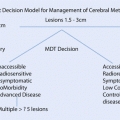Fig. 7.1
a Wise-pattern incision b Radial incision, «lazy-S» c Periareolar incision, may be extended medially, laterally or both («omega incision») d Submammary fold incision, extended laterally (Used with permission from Lucy Bai. Illustration credit: Lucy Bai)
In woman with large or very ptotic breasts, a reduction of the skin envelope is needed. This can be achieved using a traditional mastectomy incision with removal of the NAC but leaving more skin than when no reconstruction is planned. The nipple can be retransplanted as a full-thickness skin graft at the end of the operation. A skin-reducing mastectomy using a Wise-pattern incision is another alternative, often suitable for women with larger-sized or ptotic breasts (see ◘ Figs. 7.1 and 7.2). The NAC can be saved or removed depending on the size of the breast. In some women, a de-epithelialized dermal flap created by the skin between the inframammary fold and the upper lines of the resection may be used. This flap can be sutured to the detached lower border of the pectoralis major muscle, thus creating a wide dermo-muscular pocket for an implant [47, 48].


Fig. 7.2
a Before bilateral RRM b After RRM and reconstruction with permanent implants, submammary incision with lateral extension (same patient as a) c Before bilateral RRM, the patient has previously undergone reduction mammoplasty and lost much weight d After RRM and reconstruction with permanent expander, Wise-pattern incision (same patient as c) (Photos used with permission from Medicinsk Bild, Karolinska University Hospital, Stockholm, Sweden)
After previous breast augmentation with subpectoral implants, the mastectomy can be performed leaving the implant and surrounding capsule in place. After the skin- or NAC-sparing mastectomy, the skin envelope can either be reduced or left unchanged depending on breast size. An alternative is placing an expander in the implant pocket. A retrospective review of cancer patients with pre-existing subpectoral implants compared placing an immediate tissue expander [49] to implant-sparing mastectomy followed by delayed implant exchange [50] and found more complications in the tissue expander group [51].
7.6 Breast Reconstruction
7.6.1 Implant-Based Reconstruction
Reconstruction using permanent implants is the most straightforward method that enables a cosmetically satisfactory result in women with small breasts (◘ Fig. 7.2). Elasticity of the pectoralis major muscle will be the size-limiting factor in many patients. After finishing the mastectomy, a subpectoral pocket is created for the implant by lifting the pectoralis major muscle from underlying pectoralis minor muscle and chest wall. Electrocautery is useful for this dissection, and the surgeon positioned on the cephalad side of the arm helps giving a good view of the caudal portion of the pocket. Lateral coverage of the implant can be achieved by mobilising the serratus anterior muscle. An acellular dermal matrix [7] or a synthetic mesh can be used to increase the size of the sub-muscular pocket and improve the projection in the caudal part of the breast. ADMs are matrix grafts derived from allogenic and xenogenic dermis intended to provide a scaffold for the patient’s own cells. Some patients may benefit from this, but it is still a controversial technique associated with high costs and possible increased complication rates [52, 53]. Long-term follow-up regarding quality of life has been published but is lacking regarding cosmetic outcomes [54].
In women with larger breast sizes, an expander-based reconstruction is needed. This technique has been widely used for reconstruction after bilateral RRM with good results, relatively low complication rates and high patient satisfaction [29, 35, 55].
Regardless of the chosen reconstruction mode, RRM is a major surgical event and women need extensive preoperative information about the extent of the procedure, the risk for complications and the possibility of revision surgeries. Smoking, high body mass index and preoperative irradiation are well-known predictors of complications [56]. Tobacco users should be encouraged to stop smoking at least 4 weeks before and 4 weeks after surgery, as this substantially reduces the risk for complications [57].
7.6.2 Autologous Reconstruction
Free flap reconstructions are less frequently used for bilateral RRM, whereas the latissimus dorsi (LD) flap in combination with implants is well suited for women with larger breast volumes and higher body mass index. However, free flaps are superior for reconstruction in women with a previous breast cancer who have undergone chest wall irradiation, where an implant-based reconstruction may cause major surgical challenges and more revisional surgeries. The free flaps are considered superior to implant-based reconstruction for many patients due to the resulting soft natural breast mound and the longevity of the aesthetic results. The complexity associated with autologous breast reconstruction must be remembered, with increased operative times, involved microsurgical techniques and potential for surgical morbidity at two separate sites. In the Swedish national inventory of bilateral RRM, one site solely performed autologous reconstructions. Their complication rate was higher, and their need of blood transfusion exceeded that compared to the implant-based cohort [29]. When compared for costs and complications, LD flaps were more costly but not associated with more complications than the implant-based reconstructions in 50 UK patients (19/50 were RRM, the remaining had a personal history of breast cancer) [58]. Techniques for reconstruction vary depending on local traditions between countries and regions. A high frequency of autologous flaps has been reported from Helsinki, Finland, where a majority of patients chose LD flaps or free flaps. They report 25 out of 80 breasts reconstructed with different free flaps such as the transverse rectus abdominis musculo (TRAM)-cutaneous flaps, superficial inferior epigastric abdominal (SIEA) perforator flaps, transverse myocutaneous gracilis (TMG) flaps, deep inferior epigastric perforator flaps and 20/80 with LD flaps. Three of the free flaps were lost, and among 31 implant-based reconstructions, four implants were lost [59]. Low frequencies of complications after autologous reconstructions in the risk-reducing setting have been reported by others. A one-step procedure for bilateral RRM and RRSO has also been described, starting with salpingo-oophorectomy using open laparoscopy then bilateral immediate or delayed breast reconstruction with DIEP flaps. This was performed in eight patients with a mean duration of the entire procedure of 524 minutes and no flap loss [60]. There are no long-term follow-up studies after autologous breast reconstructions in mutation carriers, but these techniques are appealing alternatives for some, especially younger and healthy women resulting in reconstructed breasts without need for corrections and changes of implants later in life. However as the median age of this subgroup is relatively younger than in cancer patients, many do not have adequate donor site volumes for autologous bilateral reconstructions.
7.7 Risk-Reducing Bilateral Salpingo-Oophorectomy
Today most guidelines recommend RRSO at the ages 35–40 or after completion of childbearing for mutation carriers. It [9] is the most effective prevention mode for ovarian cancer in BRCA mutation carriers. The surgery is usually undertaken laparoscopically with minimal surgical morbidity. However side effects related to premature surgical menopause are common, may be very distressing and should be actively managed. These include vasomotor symptoms, loss of libido, vaginal dryness and dyspareunia, increased relative risk for cardiovascular events, osteoporosis, psychosexual and cognitive dysfunction in premenopausal women. Women may not always be adequately counselled about these side effects which may have a negative impact on quality of life and relationships. Hormone-replacement therapy may be used until approximately 50 years of age with little impact on the degree of breast cancer risk reduction [61]. Bone density monitoring with DEXA scans and appropriate use of calcium and vitamin D supplement +/− bisphosphonates may be useful especially if HRT is not used. Sexual dysfunction may be helped with oestrogen creams or simple vaginal moisturisers.
A recent hypothesis proposes that many ovarian cancers (especially high-grade serous histotype) may arise from the distal part of the fallopian tube. Furthermore epidemiologic data show a decreased risk of ovarian cancer following tubal ligation or salpingectomy. In the future, bilateral salpingectomy with ovarian retention (BSOR) [62] might become a prevention strategy for premenopausal high-risk women for whom RRSO is recommended, but are reluctant to have their ovaries removed due to hormonal implications. For these women, BSOR might be useful as a temporary measure [63–65], but currently this is not recommended outside of clinical trials.
7.8 Psychosocial Considerations
The decision process for any woman opting for an ablative procedure includes both emotional and cognitive understanding of what this entails. The permanent effects that these procedures involve need to be fully communicated. The multiprofessional and multidisciplinary team can facilitate and offer information and support in its special field of expertise. They need to balance the substantial risk-reducing effect against the small possibility of leaving residual breast tissue behind. As interpreting risk is a difficult and highly subjective matter, decision aids have been developed [66, 67]. The reported incidence of breast cancer occurring in mutation carriers varies depending on surgical technique and time of follow-up but is reported to be very low as discussed earlier. Further health-related quality of life outcomes such as body image changes, physical and sexual wellbeing and psychosocial changes that may occur should be considered and discussed.
Regarding RRSO and RRM, the overall goal for the patient, apart from risk reduction, is to reduce cancer anxiety. The reported outcomes after RRSO confirm this reduction of anxiety levels and post-operative problems relate more to menopausal symptoms from urogenital tract and sexual disturbances than regrets of having undergone the surgery. An information gap between patients and caregivers preoperatively has been described, and women have reported a preoperative lack of information regarding impact of RRSO on body image, sex life and their risks for coronary heart disease [68].
While most women are highly motivated once they come for a surgical consultation, there are a number of issues that they need to comprehend and reflect upon. Most studies reporting patient-related outcomes after RRM include women who have had reconstructive surgery of their breasts. Few studies on RRM in purely asymptomatic patients exist comparing reconstructed versus only mastectomised patients. In studies including high-risk patients with breast cancer generally, patients who had not opted for reconstruction reported higher satisfaction rates and less anxiety and bodily problems [69–71]. When evaluating the literature, it becomes clear that the instruments used are often not validated and not breast specific and that the sample sizes are small [72]. However, the results are quite unanimous in their findings. Moreover, it is difficult to deduce what role on decision-making the physicians play [72]. Halloway and colleagues conducted semi-structured interviews with 40 high-risk women 3 years after surgery and focused on two themes: looking different and feeling different. The authors concluded that although women find the procedure satisfactory in reducing the cancer risk and anxiety, careful preoperative information is mandatory as they reported being unprepared for the lack of sensation on their breasts, the severity of the menopausal symptoms and the impact on sexuality [68]. From the same research group, a prospective analysis comprising women who had either undergone RRM and RRSO or RRSO only reported few regrets and little negative impact on psychosocial functioning [73].
Satisfaction with both outcome and the decision-making is generally high in reported studies also when being asked long-term post-operatively, but enjoyment of sex was negatively impacted on in 75% of the patients [74]. Character and emotional traits like vulnerability and high cancer distress preoperatively correlated with decreased quality of life post RRM and reconstruction [71]. In a prospective study using a bespoke instrument, Gopie and colleagues showed in Dutch women that RRM and reconstruction did not affect sexual relationships if these were considered satisfying preoperatively [75]. However, body image deteriorated especially if cancer distress was high preoperatively.
Outcome studies reveal that patients’ motives for CRRM are risk reduction and to achieve symmetry and improved cosmesis [21]. Prospective studies looking at complications following CRRM report that the surgical challenge is the cancer side and that of achieving a satisfactory result after adjuvant treatment. Especially when radiotherapy is needed to one side as part of cancer treatment, multiple revision surgeries are often necessary. Otherwise outcome measures are similar to those after bilateral RRM [76, 77].
7.9 Surveillance After Risk-Reducing Surgery
Guidelines for surveillance after risk-reducing surgery are less consistent than for mutation carriers who have not undergone surgery. In a survey of surveillance schemes from 22 centres in 16 countries in Asia, Australia, Europe and North America, most centres offered annual clinical breast exam, while four centres offered annual MRI, primarily for substantial residual breast tissue after RRM. Only four centres offered specific gynaecological surveillance after RRSO [4].
7.10 Conclusion
To conclude BRCA1 and BRCA2 mutations carry a high risk for cancer in both breasts and ovaries/fallopian tubes. Prophylactic mastectomy and salpingo-oophorectomy substantially reduce the cancer risk and improve survival. All mutation carriers should be offered counselling by a multiprofessional team about risks and surgical options.
References
1.
Chen S, Parmigiani G. Meta-analysis of BRCA1 and BRCA2 penetrance. J Clin Oncol. 2007;25(11):1329–33.CrossrefPubMedPubMedCentral
2.
Gabai-Kapara E, Lahad A, Kaufman B, Friedman E, Segev S, Renbaum P, et al. Population-based screening for breast and ovarian cancer risk due to BRCA1 and BRCA2. Proc Natl Acad Sci U S A. 2014;111(39):14205–10.CrossrefPubMedPubMedCentral
3.
Rhiem K, Engel C, Graeser M, Zachariae S, Kast K, Kiechle M, et al. The risk of contralateral breast cancer in patients from BRCA1/2 negative high risk families as compared to patients from BRCA1 or BRCA2 positive families: a retrospective cohort study. Breast Cancer Res. 2012;14(6):R156.CrossrefPubMedPubMedCentral
4.
Madorsky-Feldman D, Sklair-Levy M, Perri T, Laitman Y, Paluch-Shimon S, Schmutzler R, et al. An international survey of surveillance schemes for unaffected BRCA1 and BRCA2 mutation carriers. Breast Cancer Res Treat. 2016;157(2):319–27.CrossrefPubMedPubMedCentral
5.
6.
Jacobs IJ, Menon U, Ryan A, Gentry-Maharaj A, Burnell M, Kalsi JK, et al. Ovarian cancer screening and mortality in the UK collaborative trial of ovarian cancer screening (UKCTOCS): a randomised controlled trial. Lancet. 2016;387(10022):945–56.CrossrefPubMedPubMedCentral
7.









